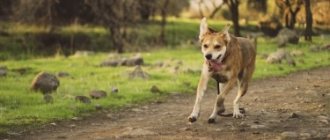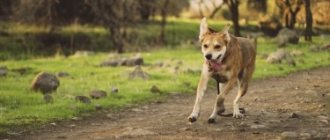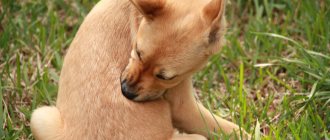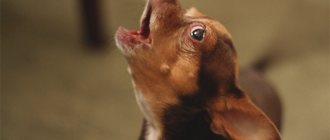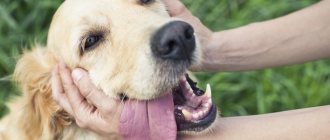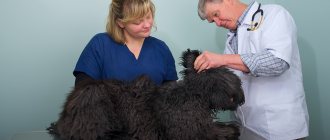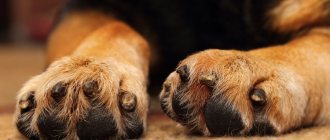Many dog owners sooner or later face the problem of a cracked or torn nail. This is very serious, because it means severe pain and discomfort for the pet. In addition, the wound may bleed.
If a person encounters such an incident for the first time, he may panic and provide incorrect assistance, which can subsequently lead to infection or improper growth of the claws .
Therefore, it is recommended that you familiarize yourself with the rules of first aid in advance, and also get a veterinary first aid kit if you don’t already have one.
The main causes of injuries on the front and hind legs
An active and agile dog can break a claw in a wide variety of situations - while chasing a cat or in a fight with relatives, or in an unsuccessful jump from a height. A common cause of injury is the tendency of many dogs to dig holes in hard ground and sand. Having caught on snags, bumped into hard objects with their paws, stones, bricks, the claws are the first to break and break.
Old animals are predisposed to orthopedic problems due to the development of dryness of not only the skin, but also the stratum corneum. Brittle and dry claws will break off sooner or later.
Keeping pets in a dry room, especially in winter when central heating is on, is often accompanied by claw injury. As a rule, a dog’s extra claws are susceptible to the problem, since the support claws grind down naturally and do not stick out to the sides.
Veterinary experts believe that an unbalanced diet and the presence of diseases of the endocrine system and internal organs can lead to damage. Thus, with a deficiency of vitamin A, biotin, B vitamins, zinc, selenium, and iron, separation of the stratum corneum, dryness and brittleness of the nails are noted.
Dog “manicure” also suffers from diseases of the thyroid gland, disorders of mineral metabolism, and liver pathologies.
We recommend reading about how to stop bleeding in a dog. From the article you will learn how to stop stomach bleeding, bleeding from the mouth, nose, nails and uterus.
And here is more information about a broken paw in a dog.
Diagnosis
As a rule, a differential diagnosis is made first. This is a complete list of diseases with similar symptoms. In our case, it includes: the possible presence of fungal and bacterial infections, drug dermatitis, vasculitis and autoimmune diseases.
Then, after a series of examinations, we were given a final diagnosis: Lupoid onychodystrophy.
Why exactly this, and why, say, not a fungal infection or injury? Yes, because with injuries, the claw plate grows normally and the lesions will not be so generalized (spreading over all limbs). And a fungal infection does not cause rejection of the nail plate.
Well, the surest way to make a final diagnosis is histopathological examination of the material (amputation of the phalanx of the finger along with the claw). As a rule, owners of four-legged animals rarely give their consent to this type of research.
Signs that a dog has a broken nail
The injury received by an animal, as a rule, does not go unnoticed by attentive owners. The animal, which previously ran carefree during a walk or indoors, begins to limp. The dog tries not to step on the injured limb and keeps it suspended. Many individuals try to lick the painful area. Due to the fact that animal claws are equipped with blood vessels, their damage is most often accompanied by bleeding.
Upon visual inspection, the owner will find that the nail is either broken or completely torn out from the nail fold. The damage should be examined very carefully, as the slightest touch brings severe pain to the pet.
First aid: what painkiller to give, how to treat
Having discovered an injury, the owner must competently provide first aid to his four-legged friend. If the damage is accompanied by bleeding, then first of all measures are taken to eliminate it. It is best to examine a restless individual with an assistant who will hold the dog firmly during manipulations.
First, you need to inspect the wound for the presence of foreign objects - glass and metal fragments, wood chips, splinters, thorns, sharp thorns, pine or spruce needles, plant seeds.
Bleeding from a damaged claw can be removed in several ways: using a hemostatic pencil, hydrogen peroxide, baby powder, potassium permanganate solution. To quickly stop bleeding, apply a pressure bandage or gauze.
The most crucial moment when providing first aid to an animal is removing a broken nail. If the injury occurred closer to the end of the horn formation, then you can break off the damaged area using special nail clippers. Use a nail clipper to remove the hanging fragment with a quick but confident movement.
As a rule, such manipulation is painful for the dog, but the pain is immediate. If the damage is located near the base of the claw, you should not carry out the manipulation yourself.
The owner's next step should be to prevent infection of the open injury by infectious factors. A feature of the anatomical structure of the claw is its connection with the bone structures of the limb.
Therefore, it is important to prevent dirt from getting into the wound. To this end, the owner must carry out antiseptic treatment of the damaged area. This can be done with the help of antibacterial compounds - Miramistin, Chlorhexidine solution, Furacilin. If you have a special iodine-based wound remedy in your medicine cabinet - Monclavit - then its simple and convenient use will facilitate antiseptic treatment.
If possible, the open injury can be sprinkled with streptocide powder. If you have an anti-inflammatory ointment on hand, for example, Levomikol, Tetracycline, then you can also use a creamy form of antiseptic. The paw should be placed in a clean cotton sock or bandaged to prevent the wound from becoming infected.
Contacting a veterinarian for a claw injury
Considering the complex structure of the claws, their proximity to bone formations, the risk of infection and the development of inflammation of surrounding tissues, after first aid is provided, the animal must be taken to a specialized institution. Qualified help is necessary for incessant bleeding, severe lameness that does not go away over time.
You should also contact a veterinarian if the claw is damaged in close proximity to the paw.
During the examination, the doctor will first clean the wound and perform an antiseptic treatment. If the pain is severe, the animal will be sedated to remove the broken claw. The manipulation is carried out with a special surgical instrument, which allows you to quickly and without dissecting the stratum corneum to trim the damaged claw. Then the bleeding is stopped and an aseptic bandage is applied to the paw.
Broken Claw
Orthopedic trauma in an animal is associated with severe pain. In some cases, a veterinarian uses painkillers - Baralgin, Spazgan - to reduce the pet's suffering.
After claw removal
If there is a threat of penetration of pathogenic microorganisms into deep tissues, the furry patient is prescribed a course of antibacterial drugs. For preventive purposes, antibiotics with a wide spectrum of action are used - Baytril, Cobactan, Cefatoxime.
Recommendations for further treatment of the wound surface depend on the degree of damage. As a rule, care consists of applying an anti-inflammatory ointment to the wound, for example, Levomycetin, Ichthyol, Vishnevsky's liniment.
The animal should be given complete rest and the duration of walks should be reduced. To speed up wound healing, a veterinarian may recommend enriching your pet’s diet with vitamins A and E, biotin, selenium, zinc, and sulfur using multivitamin and mineral supplements.
To see what can happen if you don’t remove a dog’s broken claw, watch this video:
What is the danger?
If a dog's claw breaks off, then such an injury is actually not as harmless as it might seem. What the owner definitely shouldn’t do is ignore the situation. The most important thing is that the situation becomes more complicated if there is heavy bleeding. As already mentioned, a large number of blood vessels are collected inside the claw. In addition, there is a connection with the bone, which can lead to infection in the body. If nothing is done, this can develop into inflammation, blood poisoning, and so on.
Prevention of nail damage in dogs
Considering the prevalence of the problem, orthopedic veterinarians and experienced dog breeders recommend that owners of four-legged friends adhere to the following rules for care and maintenance:
- Trim overgrown nails regularly. The overgrown stratum corneum clings to hard surfaces and sooner or later will lead to injury. Neglecting this simple hygiene procedure will protect your dog from painful injuries.
- The manipulation should be carried out using a special tool for trimming animals. The nail clipper should be made of high-quality metal, which will prevent the occurrence of hangnails and delaminations when trimming the nail. Particular attention should be paid to additional claws, which, due to their physiological characteristics, grow faster.
- The animal's diet must be balanced in nutrients, vitamins and microelements.
- In winter, when keeping dogs in heated rooms, it is recommended to humidify the air using an air conditioning system and sprayers.
We recommend reading about eye injury in dogs. From the article you will learn about the causes of eye injuries in dogs, types of injuries, diagnosis of the condition of the cornea and other parts of the eye, and treatment.
And here is more information about how to treat a dog’s wound.
A broken claw can cause serious problems for your four-legged friend in the form of bleeding and pain. The owner’s task is to be able to competently provide first aid to the animal and deliver it to the clinic as soon as possible. An examination by a veterinarian is necessary if there is bleeding from the wound, severe lameness and pain.
Treatment consists of complete or partial removal of the damaged nail, stopping bleeding and antiseptic treatment of the wound.
If the nail is broken at the root
If a dog's claw is torn out, what should you do? The situation will essentially be approximately the same. The person is required to provide first aid, carefully treat the wound, and then take the pet to the doctor.
The owner’s actions, when a layer or the entire nail is torn out at the root, should be as follows:
- It is necessary to carefully rinse the animal's paw with warm water.
- Treat the wound with a special substance.
- Cover with a bandage to prevent further infection.
- Show the dog to the doctor.
Important! It is advisable to apply a special antibiotic ointment or powder to the wound after washing.
Useful video
To learn how to properly trim a dog's nails, watch this video:
Similar articles
- Cracks on dogs' paws, pads: causes...
...damaged skin treated with an antiseptic and fixed with gauze... Trim the dog's claws in a timely manner, as when they grow excessively, injuries... Read more - How to stop bleeding in a dog if it...
Dogs often get injured while walking, fighting with relatives, or chasing cats. ... Damaged claw with a careful but confident movement... Read more
- A broken paw in a dog: how to determine the front...
A limb fracture in dogs is a serious injury characterized by pain and loss of the injured paw’s support function. Read more
- How to treat a dog’s wound, treat purulent, lacerated...
A dog's rough tongue irritates damaged tissues and leads to infection of a clean wound. Read more
- Eye injury in a dog: causes, treatment, dog after...
Eye injury from a cat's claw. ... Dogs can scratch the damaged organ with their paws and thereby worsen the situation. Read more
Preventive actions
In order to worry less about why your dog’s nail has fallen off or broken, it is recommended to take certain preventive measures. Experienced dog breeders and veterinarians recommend that pet owners adhere to the following rules:
- Check and trim growing nails regularly. During growth, if you do not watch them, they can become twisted and prevent the animal from moving normally. In addition, they will constantly cling to everything when walking.
- For cutting, use only special dog scissors. Conventional ones disrupt the structure and lead to delamination. In addition, you can accidentally pull out a piece of nail from your finger.
- You only need to trim to a certain level. If you touch the vessels, blood begins to flow, and the dog becomes painful.
- It is imperative to monitor your dog’s diet so that it receives all the necessary elements and minerals.
Absolutely any dog is capable of tearing out or breaking a nail. Therefore, it is very important to monitor and care for your pet. It is also recommended to choose special, well-kept places for walking, where he will not encounter foreign objects or construction debris.
